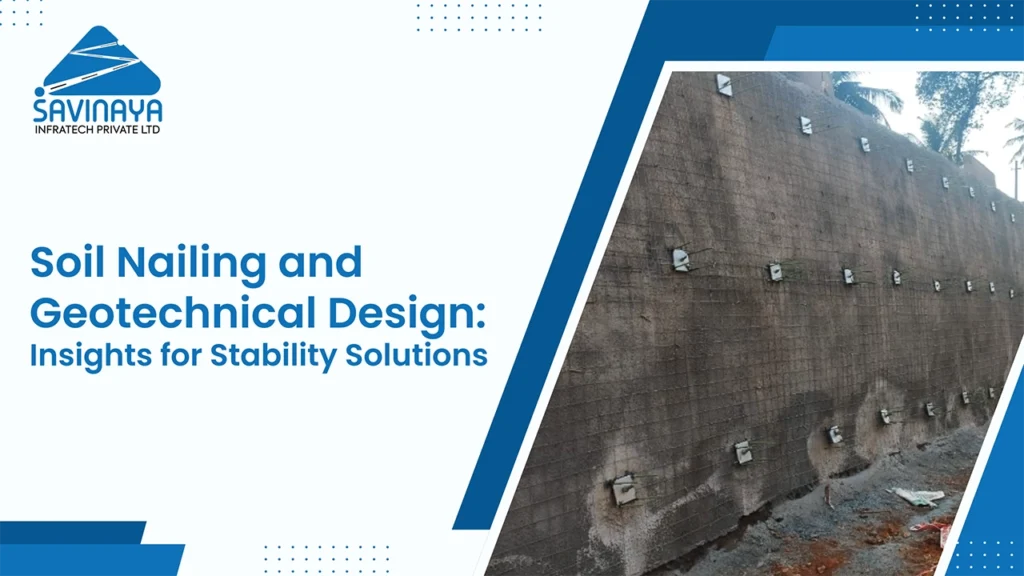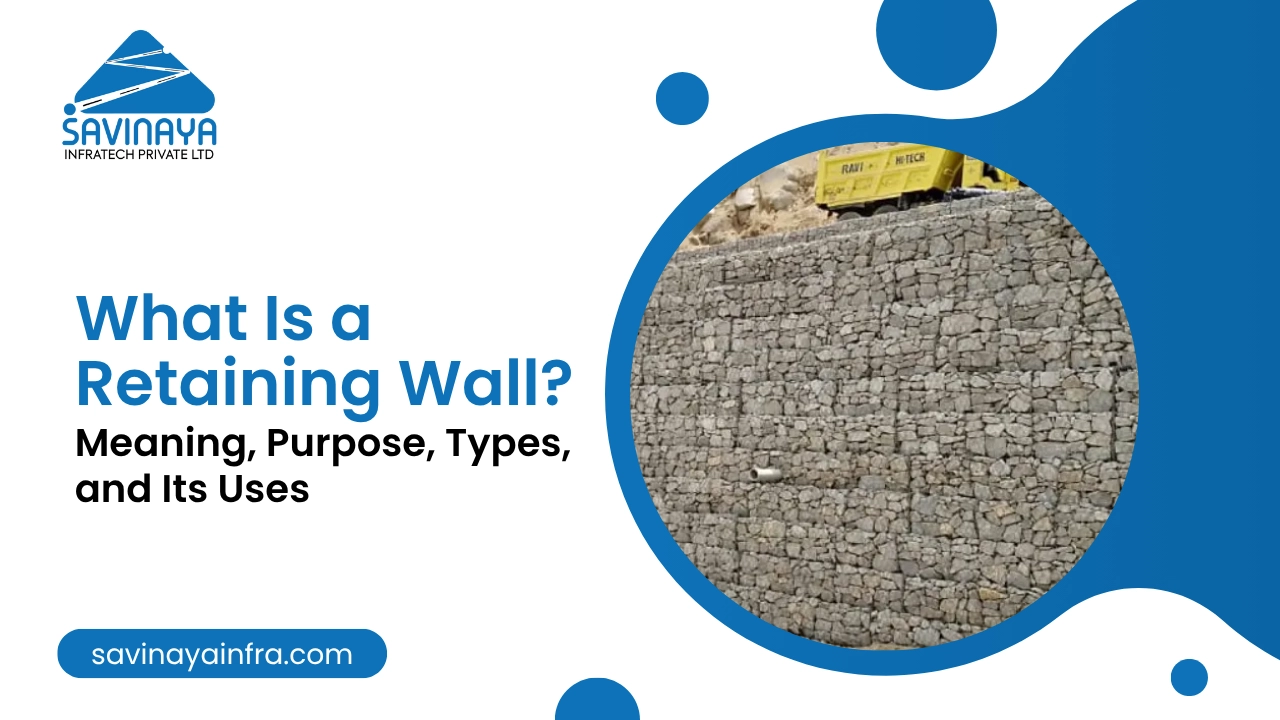Ensuring soil stability is one of the biggest challenges in geotechnical engineering, and innovative techniques like soil nailing have transformed the way we reinforce slopes, retaining walls, and excavations. This method has gained popularity for its cost-effectiveness, durability, and efficiency in stabilizing soil structures.
From wall nailing in deep excavations to slope stabilization and erosion control, soil nailing techniques are vital in improving ground conditions. This blog explores the fundamentals of soil nailing, its applications, its advantages, and how it compares to other ground improvement methods.
Table of Contents
What is Soil Nailing? A Revolutionary Ground Improvement Technique
Soil nailing is a technique used to reinforce and stabilize soil by inserting steel nails into the ground. Much like nail walls in construction, where fasteners strengthen a structure, soil nails create a solid framework within the soil to prevent movement.
How Does Soil Nailing Work?
The soil nailing technique follows these steps:
- Drilling – Holes are drilled into the soil at specific angles.
- Inserting Soil Nails – Steel bars or nails are placed into the drilled holes.
- Grouting – The nails are bonded with grout to improve strength and durability.
- Applying Facing – Shotcrete, mesh, or concrete panels are added to create a reinforced soil wall for extra support.
This method enhances soil strength, making it more resistant to pressure from slopes, deep excavations, and environmental forces like rainfall and earthquakes.
Key Applications of Soil Nailing in Geotechnical Engineering
Soil nailing is a versatile ground improvement solution used in various civil engineering projects. Some common applications are:
1. Retaining Walls and Deep Excavation Support
Traditional retaining walls require heavy materials and significant structural work. In contrast, soil nailing techniques provide a more efficient and cost-effective way to support excavation sites and prevent wall failures.
2. Slope Stabilization and Erosion Control
Slopes are vulnerable to landslides, especially in areas with heavy rainfall or weak soil. Soil nailing strengthens slopes, reducing movement and improving overall stability. It is an essential technique for erosion control, ensuring long-term soil retention.
3. Highway and Bridge Embankments
Infrastructure projects like highways and bridges often require stabilizing embankments to prevent soil collapse. Reinforced soil walls created through soil nailing help support roadways and prevent erosion.
4. Tunnel and Underground Construction
In tunnel excavations, wall nailing is crucial for preventing collapses and ensuring underground stability. The soil nailing technique secures tunnel walls, making construction safer and more efficient.
Soil Nailing vs. Other Ground Improvement Techniques
Soil nailing is just one of many ground improvement methods used in geotechnical engineering. Below is a comparison of soil nailing with other popular stabilization techniques:
| Technique | Advantages | Limitations |
|---|---|---|
| Soil Nailing | Cost-effective, fast installation, minimal excavation | Less effective in loose or sandy soils |
| Anchored Retaining Walls | Strong support, long lifespan | Expensive and complex to install |
| Sheet Piling | Good for deep excavations and waterlogged soils | Costly materials, noisy installation |
| Gabion Walls | Eco-friendly, provides natural drainage | Requires large space |
| Reinforced Soil Walls | Strong, durable, and aesthetically flexible | Requires proper soil assessment |
Advantages of Using Soil Nailing for Stability Solutions
Why choose soil nailing over other ground improvement methods? Here are the main benefits:
- Cost-Effectiveness: Requires fewer materials and labour compared to traditional reinforced soil walls.
- Fast and Efficient Installation: Soil nailing techniques reduce construction time, making projects more efficient.
- Minimal Excavation Required: Unlike anchored retaining walls, nail walls require minimal disruption to the surrounding environment.
- Versatility: Can be used in various soil types and for a wide range of construction projects.
- Improved Soil Strength: Increases load-bearing capacity and reduces erosion risks, making it ideal for slope stabilization and erosion control.
Challenges and Considerations in Soil Nailing Design
Although soil nailing techniques offer significant benefits, engineers must address certain challenges during implementation:
- Soil Suitability: Works best in cohesive or semi-cohesive soils but may be ineffective in loose sand.
- Corrosion Risks: Soil nails must be coated or made from corrosion-resistant materials to ensure longevity.
- Proper Installation Required: Errors in drilling, grouting, or nail placement can impact structural integrity.
How Savinaya Can Help with Soil Nailing Solutions?
At Savinaya Infra, we provide high-quality soil nailing techniques for projects requiring slope stabilization, retaining walls, erosion control, and deep excavation support. Our team of geotechnical experts ensures precision in every step, from soil analysis and design to installation and quality assurance.
Whether you’re working on a highway embankment, underground tunnel, or reinforced soil wall, we deliver ground improvement solutions that enhance safety, durability, and cost-efficiency. With a focus on advanced materials, innovative technology, and sustainable practices, Savinaya Infra is your trusted partner in soil stabilization and geotechnical engineering.
The Future of Soil Nailing in Geotechnical Engineering
With advancements in construction materials and technology, soil nailing techniques continue to evolve. Some emerging trends include:
- Advanced Materials: Corrosion-resistant coatings and high-strength steel nails improve durability.
- Automated Installation: Robotics and AI are enhancing precision in wall nailing and excavation support.
- Eco-Friendly Innovations: Sustainable grouting and green facings are reducing the environmental impact of reinforced soil walls.
Recommended Reads
Top 4 Soil Stabilization Techniques in India
A Comprehensive Guide: Soil Nailing vs Soil Anchoring
Soil Nailing or Soil Anchoring: Which One to Choose for Your Project?
Final Thoughts
From retaining walls to slope stabilization, soil nailing techniques offer a practical and effective way to reinforce soil structures. By providing stability without extensive excavation, soil nailing is a cost-effective and environmentally friendly ground improvement solution.
As geotechnical engineering continues to evolve, soil nailing will remain a key player in infrastructure development, ensuring safer roads, tunnels, and embankments. If your project requires erosion control, deep excavation support, or reinforced soil walls, consider soil nailing techniques for long-term stability and performance.
Looking for expert guidance on soil nailing solutions? Savinaya Infra is here to help. Contact us today and build with confidence!


